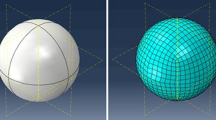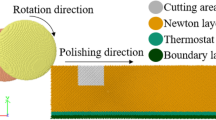Abstract
The surface planarization in the chemical mechanical planarization is mainly realized by the mechanical effect which depends on the micro-tribology behavior of nanoparticles. The material removal rate is decreased and micro-scratch is generated in the wafer surface due to the agglomeration of particles. The slurry particles hold definite energy level and microstructure which makes the classical materials processing theory unable to give reasonable explanation about this process. Large-scale classical molecular dynamic simulation of interaction among nanoparticles and solid surface has been carried out to investigate the evolvement mechanism of particle cluster and surface planarization. It is showed that the particle aggregation behavior is a size-dependent process because of the high ratio of surface atoms to bulk atoms which leads to the active reactivity and catalytic activity of nanoparticles. The substrate materials (nanoparticle) become transforming from low-energy stable system to high-energy unstable system after the two-body collision which is favorable for aggregation process. There exists obvious geometry boundary between the particle elements in the large aggregates and only the dendritic aggregates formed. The larger particles have definite microstructure and additional internal degree of freedom which can be used to take up, store, and transfer energy, thus lower the activity of chemical reaction which weaken the particle aggregation process.
Similar content being viewed by others
References
Preston FW (1937) The theory and design of plate glass polishing machine. J Soc Glass Tech 11(44):214–256
Nguyen VH, Shi FG (2000) Modeling of the removal rate in chemical mechanical polishing. Proc SPIE Int Soc Opt Eng 4181:161–167
Fu G, Chandra A, Guha S (2001) A plasticity-based model of material removal in chemical–mechanical polishing (CMP). IEEE Trans Semicond Manuf 14(4):406–417
Luo JF, Dornfeld DA (2003) Effects of abrasive size distribution in chemical mechanical planarization: modeling and verification. IEEE Trans Semicond Manuf 16(3):469–476
Runnels SR, Kim I, Schleuter J (1998) Modeling tool for chemical–mechanical polishing design and evaluation. IEEE Trans Semicond Manuf 11(3):501–510
Litton DA, Garofalini SH (2001) Modeling of hydrophilic wafer bonding by molecular dynamics simulations. J Appl Phys 89(11):6013–6023
Young-Jae K, Prasad Y, Nagendra Kim In-Kwon, Seok-Jo J, Jin-Goo P (2010) Synthesis of Fe metal precipitated colloidal silica and its application to W chemical mechanical polishing (CMP) slurry. J Colloid Interface Sci 349(1):402–407
Han XS, Hu YZ, Yu SY (2009) Investigation of material removal mechanism of silicon wafer in the chemical mechanical polishing process using molecular dynamics simulation method. Appl Phys A 95(3):899–905
Han XS (2007) Study micromechanism of surface planarization in the polishing technology using numerical simulation method. Appl Surf Sci 253(14):6211–6216
Li SH, Miller RO (2000) Chemical mechanical polishing in silicon processing. Wiley-Interscience, New York
Haile JM (1997) Molecular dynamics simulation-element method. Academic, San Diego
Ueda K, Fu HN, Manabe K (1999) Atomic scale level chip formation of amorphous metal investigated by using AFM and MD-RPFEM simulation. Machi Sci Technol 3(1):61–75
Komanduri R, Chandrasekaran N, Raff LM (2001) MD simulation of exit failure in nanometric cutting. Mater Sci Eng 311(1–2):1–12
Han XS, Yu SY (2005) Molecular dynamics simulation of nanometric cutting process based on symplectic algorithm, Trans. CSME 41(4):17–21
Toenhoff HK, Regent C (1999) Process monitoring in grinding using micromagnetic techniques. Int J Avd Manufact Technol 15(10):694–698
Han XS, Yu SY (2004) Molecular dynamics simulation of nanometric grinding-the effect of crystal anisotropy on the quality of machined surface. Key Eng Mater 258–259:361–365
Zhang LC, Tanaka H (1998) Atomic scale deformation in silicon monocrystals induced by two-body and three-body contact sliding. Tribol Int 31(8):425–433
Tersoff J (1989) Modeling solid state chemistry: interatomic potential for multicomponent systems. Phys Rev B39:5566–5570
Author information
Authors and Affiliations
Corresponding author
Rights and permissions
About this article
Cite this article
Han, X., Gan, Y.X. Investigation the complex dynamic evolvement mechanism of particle cluster and surface integrity in the chemical mechanical planarization. Int J Adv Manuf Technol 64, 13–22 (2013). https://doi.org/10.1007/s00170-012-3996-4
Received:
Accepted:
Published:
Issue Date:
DOI: https://doi.org/10.1007/s00170-012-3996-4




